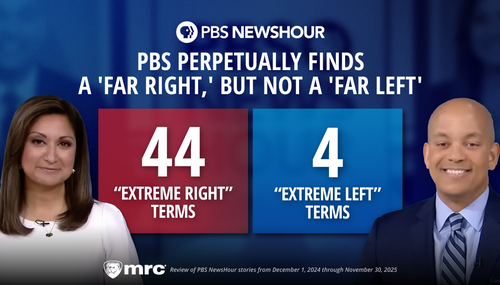PBS News Hour’s most biased reporter, White House correspondent Laura Barron-Lopez, filed a wide-ranging story Monday about some of the more controversial figures in the orbit of Donald Trump’s administration, yet also spread the ridiculous notion that Trump himself is an anti-Semite (if so, he’s doing a very bad job of it).
Her sole guest was Jacob Ware, described by Barron-Lopez as a “research fellow at the Council on Foreign Relations studying domestic terrorism and counterterrorism.” Left out: Ware is the co-author of God, Guns, and Sedition – Far Right Terrorism in America, which radical professor (and PBS favorite) Cynthia Miller-Idriss praised in a blurb as “A vital addition to the global understanding of supremacist terror and….indispensable reading for anyone seeking to understand what is demonstrably the most pressing threat to democracy and social cohesion.”
Not exactly a balanced perspective, then.
Even though Trump has come down hard on elite colleges for their tolerance of anti-Semitism against Jewish students on campus, Barron-Lopez saw every controversial Trump move through an anti-Semitic prism, running down an old list.
LAURA BARRON-LOPEZ: The president has also embraced figures and symbols that perpetuate antisemitism in some cases, including he posted a meme on social media recently that features Pepe the Frog, a symbol of white supremacist movements. And the president previously dined with white supremacist Nick Fuentes. And his Bedminster club hosted Timothy Hale-Cusanelli, who prosecutors called a Nazi sympathizer and who has a history of antisemitic rants. The president says that his attacks on universities, that his restrictions that he's placing on universities like Harvard are in the name of combating antisemitism. But does this track record show the opposite?
Her guest indulged in the lie that won’t die regarding Trump and the march in Charlottesville.
JACOB WARE: Well, actually, Laura, this is something that does go back to the first administration, the place where we saw this rapprochement between Trump and the violent far-right. The first time we saw that was at Charlottesville, where a white supremacist attack happened on behalf of an overtly neo-Nazi cause with people who were there as overt neo-Nazis. And he, of course, said there were very fine people on both sides.
Regarding Charlotteville, Trump went on to say that “I'm not talking about the neo-Nazis and the white nationalists, because they should be condemned totally.” Of course, Barron-Lopez didn’t challenge Ware on his mischaracterization of Trump’s words, and he went on.
WARE: Years later, he told the Proud Boys during a presidential debate to stand back and stand by. So President Trump has repeatedly, during his time in office, appealed to not just people who have what you might call far-right ideology or views, but even people who are willing to act out in violence on behalf of those views. What is less clear to me is whether President Trump shares these memes, these ideas deliberately, whether it's a dog whistle, whether it's unknown. But either way, it's clearly a message being sent to the far right, whether overt or covert, that they have a defender in the White House.
This segment has been brought to you in part by Raymond James.
A transcript is available, click “Expand.”
PBS News Hour
6/9/25
7:33:37 p.m. (ET)
Laura Barron-Lopez: The president has also embraced figures and symbols that perpetuate antisemitism in some cases, including he posted a meme on social media recently that features Pepe the Frog, a symbol of white supremacist movements.
And the president previously dined with white supremacist Nick Fuentes. And his Bedminster club hosted Timothy Hale-Cusanelli, who prosecutors called a Nazi sympathizer and who has a history of antisemitic rants.
The president says that his attacks on universities, that his restrictions that he's placing on universities like Harvard are in the name of combating antisemitism. But does this track record show the opposite?
Jacob Ware: Well, actually, Laura, this is something that does go back to the first administration, the place where we saw this rapprochement between Trump and the violent far right.
The first time we saw that was at Charlottesville, where a white supremacist attack happened on behalf of an overtly neo-Nazi cause with people who were there as overt neo-Nazis. And he, of course, said there were very fine people on both sides. Years later, he told the Proud Boys during a presidential debate to stand back and stand by.
So President Trump has repeatedly, during his time in office, appealed to not just people who have what you might call far right ideology or views, but even people who are willing to act out in violence on behalf of those views.
What is less clear to me is whether President Trump shares these memes, these ideas deliberately, whether it's a dog whistle, whether it's unknown. But either way, it's clearly a message being sent to the far right, whether overt or covert, that they have a defender in the White House.




